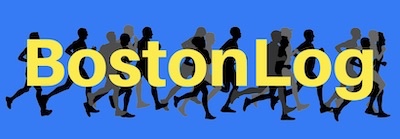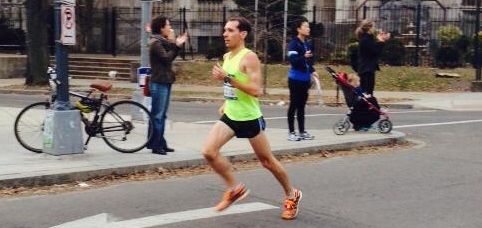How do you run a fast marathon? It’s one of the most interesting questions I can think of as a runner, training geek, and coach.
It’s also incredibly complex. With a race as long as the marathon, there are more opportunities for something to go wrong. Quite often, your finish time is more strongly influenced by outside factors than your fitness level.
Frustrating, isn’t it?
You could be in the best shape of your life, but temperature, stress levels, sun exposure, pace execution, course conditions, or fueling could completely derail your race.
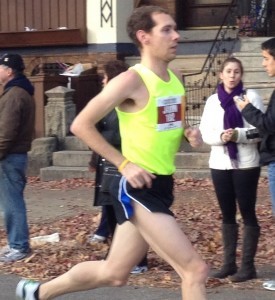
On April 21, 2014, I ran the 118th Boston Marathon and experienced a trifecta of conditions that prevented me from running a personal best. But in spite of my rookie mistakes and struggles, the experience was still one of the best days of my life.
A year after the 2013 bombings, the energy level in Boston was practically tangible. The city was alive with support and pride for what the 2014 marathon represented to Boston, victims of last year’s tragedy, and the global running community.
Being a part of that is an experience I’ll never forget – no matter my finish time.
It started on Saturday with a Strength Running meet-up where I got to hang out with many readers for the first time. I also got to see almost all of my 1-on-1 coaching runners who were competing in the race. Everyone was excited to race, spectate, and enjoy the energy of marathon weekend. I appreciated every Strength Running reader who braved the T to hang out in Faneuil Hall. I had a blast talking shop and drinking (one) beer with the group.
On Monday, I woke up at 4am – an hour earlier than my alarm – presumably because I was excited and nervous to race Boston. The morning went by uneventfully while I focused on fueling and staying warm in the Athletes Village. Soon it was time to walk to the corral and I made sure my laces were double-knotted, gels were securely positioned in my pockets, and I had an empty Gatorade bottle (you know why…).
During the walk to the corral, I was spotted by Andrew Deak, a runner I wrote a training plan for back in November. We chatted during the walk and briefly in the corral – and then he went on to run 2:40:10! Big congrats Andrew, that’s a fantastic time on the Boston course.
After the helicopter fly-over (so cool), the race started and we were off. I only managed a modified version of the Standard Warm-up with no running before the race started, so I tried to speed up gradually during the first mile. That mile went well, but soon I got too aggressive on the early downhills, as you can see from my mile-by-mile splits.
Mile 1: 6:16
Mile 2: 5:41
Mile 3: 5:48
5k: 18:23
Mile 4: 5:52
Mile 5: 6:04 (29:42)
Mile 6: 5:54
Unfortunately, you can spot some clear rookie mistakes in my splits. I underestimated the difficulty of the course, particularly the toll of running too fast on the early hills. Early speed on the downhills during the first six miles introduced significant muscle damage that caused a lot of problems later in the race.
Mile 7: 6:03
Mile 8: 6:05
Mile 9: 5:56
15k: 55:40
The rolling course left me struggling, even though my average pace through mile 10 was what I wanted. I never fell into a rhythm or felt comfortable. By mile 12, my legs felt like they should have at mile 20!
Mile 10: 6:10 (59:52)
Mile 11: 6:05
Mile 12: 6:06
20k: 1:15:25
Then, my real problems started. The heat was starting to get to me and was likely the cause of some GI distress because I simply wasn’t used to training in the heat this early in Spring. The stomach problems persisted and I needed a quick Porta-Potty stop during mile 13.
Thankfully it didn’t take too much time and I was back on pace for the next few miles. During that time my goal was to run about 6:00 pace or a little over for the rest of the race – it would still result in a big personal best.
Mile 13: 6:37
Half-marathon: 1:19:22
Mile 14: 5:54
Mile 15: 6:07 (1:30:44)
25k: 1:33:56
Mile 16: 5:55
But at mile 17 the stomach problems were back and I needed a longer bathroom stop. When I started running again, my IT band almost immediately started to hurt on the outside of my left knee. It felt fine on the uphills, but soon the big downhills were causing sharp twinges I couldn’t ignore.
Mile 17: 7:33
Mile 18: 6:23
30k: 1:54:42
Mile 19: 6:19
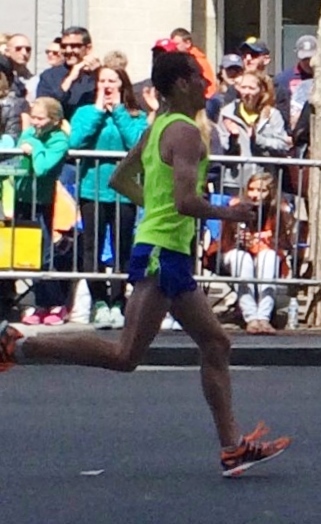 I was forced to stop four times and do leg swings to loosen the area but it didn’t help much. Slowing down on the downhills and running more conservatively was the only thing that lessened the pain.
I was forced to stop four times and do leg swings to loosen the area but it didn’t help much. Slowing down on the downhills and running more conservatively was the only thing that lessened the pain.
So by mile 20, I was resigned to run a relatively comfortable pace. A PR was out of the question, so I walked most of the remaining water stops (I think dehydration was a minor contributor to my stomach distress) to satisfy my water cravings.
Mile 20: 6:54 (2:03:51)
Mile 21: 6:47
35k: 2:15:54
Mile 22: 6:54
Mile 23: 6:53
I was still in good spirits, thriving off the unreal crowd support and giving a few waves to get the spectators cheering even louder. It was a lot of fun. 🙂
Mile 24: 6:31
40k: 2:36:40
Mile 25: 6:39 (2:37:37)
Mile 26: 6:32
Final .2: 1:18
Finish: 2:45:27
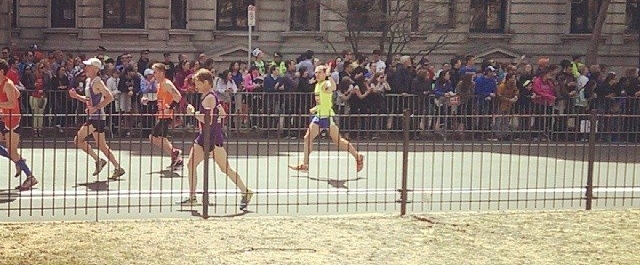 So, no warm-up, starting too fast, stomach problems, slight dehydration, warm weather, IT band pain… I had a helluva day. It seems like when something can go wrong, all the things go wrong! But there’s a silver lining to my Boston Marathon, a lesson I saw only after a few days of clarity.
So, no warm-up, starting too fast, stomach problems, slight dehydration, warm weather, IT band pain… I had a helluva day. It seems like when something can go wrong, all the things go wrong! But there’s a silver lining to my Boston Marathon, a lesson I saw only after a few days of clarity.
Even though I ran about ten minutes slower than my goal, despite all of those problems, I was a mere 4:55 slower than my PR. I walked or stopped TEN times, losing at least three to four minutes from that alone. And the course itself is significantly slower than the Philadelphia Marathon where I ran my 2:39:32 PR.
With all that adversity and the number of challenges I faced at Boston, a 2:45 ain’t too bad. I truly believe I’m in shape to run 2:35 – 2:37 on a faster course if I had a race like Philly.
And there’s the lesson: a fast marathon needs more than fitness. It requires ideal conditions, smart execution, and a course more forgiving than Boston. I failed in my execution, and other factors were out of my control; but I’m still happy with my performance, and more importantly, incredibly grateful for the experience of running the 2014 Boston Marathon.
So what to do after a race like Boston? I say enjoy a break from running. Take a week or two off and enjoy the extra time you now have. Start thinking about your next goals, but don’t rush into the training just yet. Be patient. Marathon recovery takes longer than you think.
As for me, I’m not sure what’s next on my bucket list. An ultra? A go at the Warrior Dash world championship? Another marathon? Anything is possible. And that’s precisely why we keep doing what we love to do: because anything is possible.
Jason Fitzgerald
Silver Spring, Maryland
April 21, 2014
Age – 30
Bib # 1644
2:45:27
Email: support@strengthrunning.com.
[Jason Fitzgerald is a 2:39 marathoner, USATF-certified coach, and author of the #1 selling running book on Amazon Running for Health & Happiness.
He writes for over 200,000 runners a month and has helped thousands of runners accomplish their goals with results-oriented coaching programs.
Follow him at SR STRENGTH RUNNING/ Get Stronger, Stay Healthy and Race Faster.]
